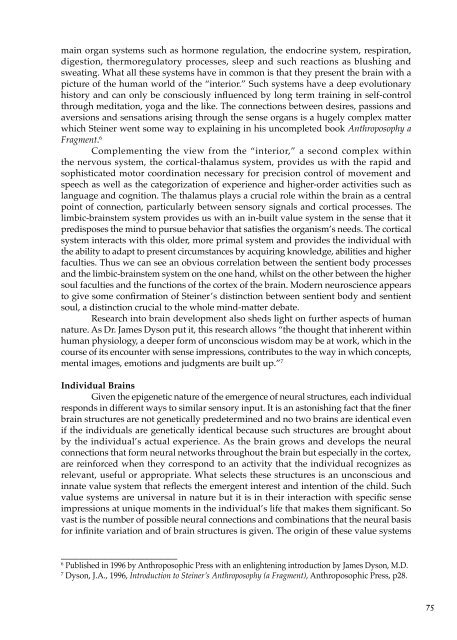The Spirit in Human Evolution - Waldorf Research Institute
The Spirit in Human Evolution - Waldorf Research Institute
The Spirit in Human Evolution - Waldorf Research Institute
Create successful ePaper yourself
Turn your PDF publications into a flip-book with our unique Google optimized e-Paper software.
ma<strong>in</strong> organ systems such as hormone regulation, the endocr<strong>in</strong>e system, respiration,<br />
digestion, thermoregulatory processes, sleep and such reactions as blush<strong>in</strong>g and<br />
sweat<strong>in</strong>g. What all these systems have <strong>in</strong> common is that they present the bra<strong>in</strong> with a<br />
picture of the human world of the “<strong>in</strong>terior.” Such systems have a deep evolutionary<br />
history and can only be consciously <strong>in</strong>fluenced by long term tra<strong>in</strong><strong>in</strong>g <strong>in</strong> self-control<br />
through meditation, yoga and the like. <strong>The</strong> connections between desires, passions and<br />
aversions and sensations aris<strong>in</strong>g through the sense organs is a hugely complex matter<br />
which Ste<strong>in</strong>er went some way to expla<strong>in</strong><strong>in</strong>g <strong>in</strong> his uncompleted book Anthroposophy a<br />
Fragment. 6<br />
Complement<strong>in</strong>g the view from the “<strong>in</strong>terior,” a second complex with<strong>in</strong><br />
the nervous system, the cortical-thalamus system, provides us with the rapid and<br />
sophisticated motor coord<strong>in</strong>ation necessary for precision control of movement and<br />
speech as well as the categorization of experience and higher-order activities such as<br />
language and cognition. <strong>The</strong> thalamus plays a crucial role with<strong>in</strong> the bra<strong>in</strong> as a central<br />
po<strong>in</strong>t of connection, particularly between sensory signals and cortical processes. <strong>The</strong><br />
limbic-bra<strong>in</strong>stem system provides us with an <strong>in</strong>-built value system <strong>in</strong> the sense that it<br />
predisposes the m<strong>in</strong>d to pursue behavior that satisfies the organism’s needs. <strong>The</strong> cortical<br />
system <strong>in</strong>teracts with this older, more primal system and provides the <strong>in</strong>dividual with<br />
the ability to adapt to present circumstances by acquir<strong>in</strong>g knowledge, abilities and higher<br />
faculties. Thus we can see an obvious correlation between the sentient body processes<br />
and the limbic-bra<strong>in</strong>stem system on the one hand, whilst on the other between the higher<br />
soul faculties and the functions of the cortex of the bra<strong>in</strong>. Modern neuroscience appears<br />
to give some confirmation of Ste<strong>in</strong>er’s dist<strong>in</strong>ction between sentient body and sentient<br />
soul, a dist<strong>in</strong>ction crucial to the whole m<strong>in</strong>d-matter debate.<br />
<strong>Research</strong> <strong>in</strong>to bra<strong>in</strong> development also sheds light on further aspects of human<br />
nature. As Dr. James Dyson put it, this research allows “the thought that <strong>in</strong>herent with<strong>in</strong><br />
human physiology, a deeper form of unconscious wisdom may be at work, which <strong>in</strong> the<br />
course of its encounter with sense impressions, contributes to the way <strong>in</strong> which concepts,<br />
mental images, emotions and judgments are built up.” 7<br />
Individual Bra<strong>in</strong>s<br />
Given the epigenetic nature of the emergence of neural structures, each <strong>in</strong>dividual<br />
responds <strong>in</strong> different ways to similar sensory <strong>in</strong>put. It is an astonish<strong>in</strong>g fact that the f<strong>in</strong>er<br />
bra<strong>in</strong> structures are not genetically predeterm<strong>in</strong>ed and no two bra<strong>in</strong>s are identical even<br />
if the <strong>in</strong>dividuals are genetically identical because such structures are brought about<br />
by the <strong>in</strong>dividual’s actual experience. As the bra<strong>in</strong> grows and develops the neural<br />
connections that form neural networks throughout the bra<strong>in</strong> but especially <strong>in</strong> the cortex,<br />
are re<strong>in</strong>forced when they correspond to an activity that the <strong>in</strong>dividual recognizes as<br />
relevant, useful or appropriate. What selects these structures is an unconscious and<br />
<strong>in</strong>nate value system that reflects the emergent <strong>in</strong>terest and <strong>in</strong>tention of the child. Such<br />
value systems are universal <strong>in</strong> nature but it is <strong>in</strong> their <strong>in</strong>teraction with specific sense<br />
impressions at unique moments <strong>in</strong> the <strong>in</strong>dividual’s life that makes them significant. So<br />
vast is the number of possible neural connections and comb<strong>in</strong>ations that the neural basis<br />
for <strong>in</strong>f<strong>in</strong>ite variation and of bra<strong>in</strong> structures is given. <strong>The</strong> orig<strong>in</strong> of these value systems<br />
_________________________<br />
6<br />
Published <strong>in</strong> 1996 by Anthroposophic Press with an enlighten<strong>in</strong>g <strong>in</strong>troduction by James Dyson, M.D.<br />
7<br />
Dyson, J.A., 1996, Introduction to Ste<strong>in</strong>er’s Anthroposophy (a Fragment), Anthroposophic Press, p28.<br />
75
















